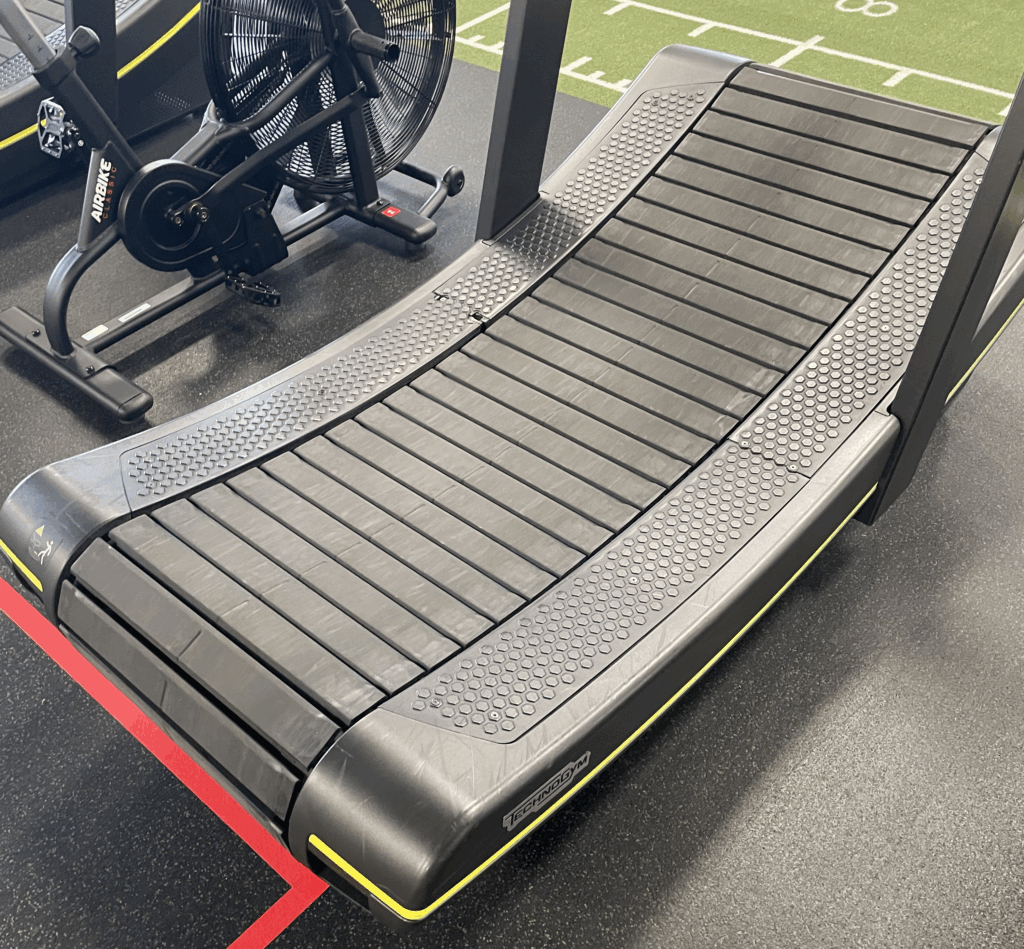For many runners, the treadmill is a necessary training partner. Whether it’s due to poor weather, time constraints, safety concerns, or the simple convenience of training at home or in the gym, treadmills offer a reliable way to keep mileage ticking over. But like any tool, they have limitations. Used correctly, they can form part of a strong training strategy. Used incorrectly, they can create bad habits that don’t translate well to road or trail running.
Let’s take a closer look at how to train effectively on treadmills, compare them with “Woodway” (often mislabelled as “Woodrow”) curved treadmills, and highlight what to focus on when you’re running indoors.

Why Pace on a Treadmill is Misleading
One of the biggest mistakes runners make is treating treadmill pace as gospel. Unlike outdoor running, where pace reflects your actual energy cost of moving across terrain, treadmill pace is artificial. Factors like motor calibration, belt tension, flywheel mechanics, and even body weight change the “true” pace.
You may think your top-of-the-range sports watch is giving you accurate data indoors, but unfortunately it isn’t. GPS doesn’t work on a treadmill, so the watch relies on its internal accelerometer to estimate speed and distance. That estimate depends on your arm swing and cadence, which can shift during treadmill running compared to outdoors. Even with calibration, there’s still a margin of error that can make the numbers misleading. I have found that the faster I run (up to a point) on a treadmill, the slower its starts to indicate I am running. This is due to my more efficient arm swing as a faster pace. In other words, don’t trust the watch any more than the treadmill display.
Instead of fixating on pace, the smarter approach is to train by duration (time spent running) and RPE (Rate of Perceived Exertion). RPE allows you to match treadmill effort to what you’d feel outside—easy, steady, tempo, threshold—without being tricked into running too hard or too easy by misleading numbers.
Why Flat Treadmill Running Isn’t Ideal
Running at 0% gradient on a treadmill doesn’t mimic outdoor running for two main reasons:
- Reduced Muscle Activation – On flat treadmills, your glutes switch off because the belt pulls your foot backward. Outdoors, you must actively extend your hip to drive forward, firing up the glutes for propulsion.
- No True Toe-Off Push – The moving belt removes the need for a full push-off phase. This means your calves and posterior chain don’t work as hard, which can create imbalances when you return to outdoor running.
The Gradient Fix – What to Set It At
Research and coaching consensus suggest that setting the treadmill at 1–2% incline best simulates running on flat road. This small gradient forces more glute and calf engagement, while also compensating for the lack of wind resistance indoors. Due to inaccurate incline calibration, you can use your judgement on the incline that feels right for you.
Curved (Woodway) Treadmills vs. Traditional Motorised Treadmills
Curved treadmills—like Woodway models—are non-motorised and rely on your own power to move the belt. This creates a much more natural running action and requires active push-off, closely mimicking outdoor mechanics. You can find more on these treadmills by visiting the Woodway website.
Curved Treadmills (Woodway-type)
- Engage the glutes and hamstrings properly
- Allow for natural push-off and stride mechanics
- Self-paced—speed adjusts instantly to effort
- Can feel harder than outdoor running, limiting session duration
- Not ideal for very long runs or precise interval work

Traditional Motorised Treadmills:
- Better for long runs, controlled pacing, and structured workouts
- Useful in extreme weather or unsafe environments
- Gentle on joints due to cushioned decks
- Artificial running mechanics—belt does some of the work
- Pace calibration varies, often inaccurate
Positives of Treadmill Training
- Consistency – You can run at any time, regardless of weather or safety.
- Controlled Environment – Great for interval training or hill sessions where you want repeatability.
- Reduced Impact – Softer deck can protect joints during high-mileage weeks.
- Mental Strength – Long treadmill runs build discipline and focus.
Negatives of Treadmill Training
- Biomechanical Changes – Reduced glute and calf activation if not set up correctly.
- Monotony – The mental grind can be harder than the physical one.
- Calibration Issues – Paces rarely match outdoor conditions.
- Limited Skill Transfer – Doesn’t prepare you for terrain changes, wind, or variable surfaces.
The Bottom Line
Treadmills are a powerful training tool, but only if you use them wisely. Don’t obsess over treadmill pace—train by time and effort. Don’t keep it flat—set the gradient at 1–2% to keep your running mechanics honest. And if you can, mix in some sessions on a curved treadmill to ensure you’re firing up your glutes and practicing true propulsion.
A treadmill should complement your outdoor training, not replace it. Use it smartly, and it can keep your fitness progressing all year round.

